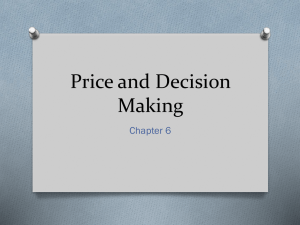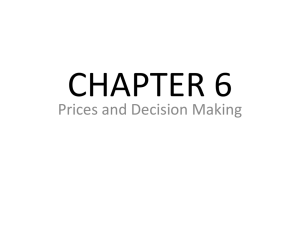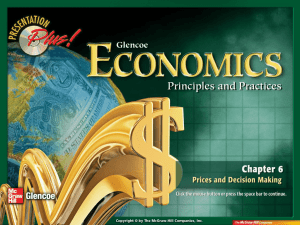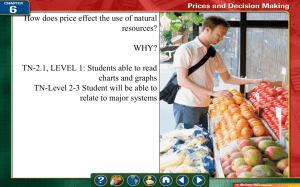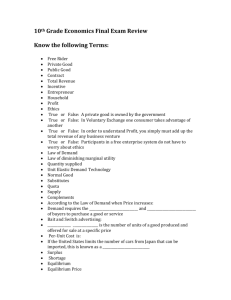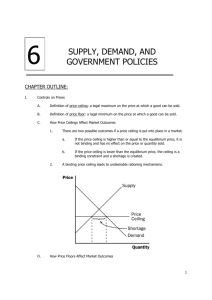Prices and Decision Making
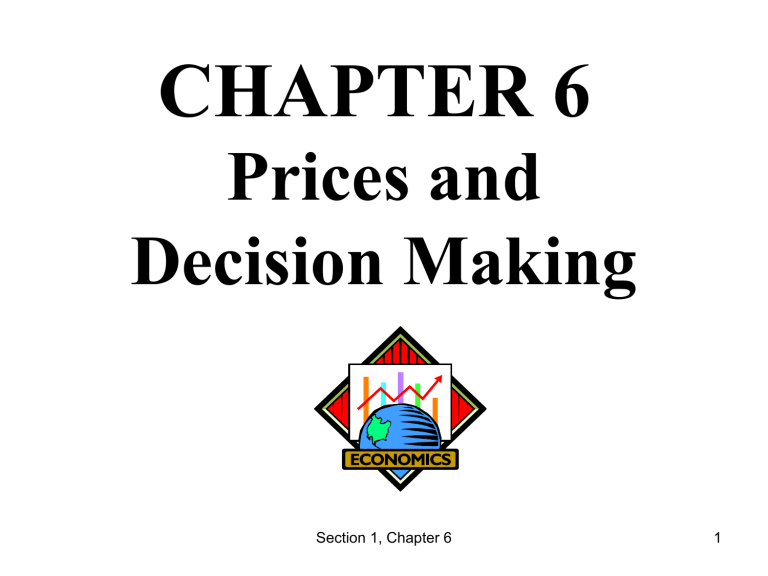
CHAPTER 6
Prices and
Decision Making
Section 1, Chapter 6 1
2
ADVANTAGES OF PRICES
Prices are neutral because they do not favor the buyer or the consumer. They are the result of competition.
Prices are flexible, allowing for the “shocks” of unforeseen events and changes in the market.
Section 1, Chapter 6 3
ADVANTAGES OF PRICES
(continued)
Prices have no administration costs.
Prices are familiar and easily understood.
Section 1, Chapter 6 4
5
ALLOCATIONS WITHOUT
PRICES
Rationing, or the system where the government decides everyone’s “fair” share, leads to the question of fairness.
Section 1, Chapter 6 6
ALLOCATIONS WITHOUT
PRICES
(continued)
Rationing leads to high administration costs.
Rationing leads to fewer incentives to work and produce.
Section 1, Chapter 6 7
PRICES AS A SYSTEM
Together, prices comprise a system that helps buyers and sellers allocate resources between markets, linking all markets in the economy.
Section 1, Chapter 6 9
THE PRICE
ADJUSTMENT PROCESS
Price adjustments help a competitive market reach market equilibrium, with fairly equal supply and demand.
Section 2, Chapter 6 10
11
THE PRICE
ADJUSTMENT PROCESS
(continued)
Surpluses occur when supply exceeds demand.
Shortages occur when demand exceeds supply.
The equilibrium price is the price at which supply meets demand.
Section 2, Chapter 6 12
EXPLAINING AND
PREDICTING PRICES
A change in price is normally the result of a change in supply, a change in demand, or both.
Section 2, Chapter 6 14
THE COMPETITIVE
PRICE THEORY
The theory of competitive pricing represents a set of ideal conditions and outcomes.
Section 2, Chapter 6 15
16
THE COMPETITIVE
PRICE THEORY (continued)
It serves as a
model to
measure market performance.
Section 2, Chapter 6 17
18
THE COMPETITIVE
PRICE THEORY (continued)
In theory, a competitive market allocates resources efficiently.
Section 2, Chapter 6 19
THE COMPETITIVE
PRICE THEORY
(continued)
To be competitive, sellers are forced to lower prices, which makes them find ways to keep their costs down.
Section 2, Chapter 6 20
THE COMPETITIVE
PRICE THEORY
(continued)
Competition among buyers keeps prices from falling too far.
Section 2, Chapter 6 21
22
DISTORTING MARKET
OUTCOMES
Achieving equity and security usually requires policies that distort market outcomes.
Section 3, Chapter 6 23
DISTORTING MARKET
OUTCOMES (continued)
One way to achieve these goals is to set
“socially desirable” prices, which interferes with the pricing system.
Section 3, Chapter 6 24
25
DISTORTING MARKET
OUTCOMES
(continued)
Setting price
ceilings affects
the allocation of resources.
Section 3, Chapter 6 26
DISTORTING MARKET
OUTCOMES
(continued)
The minimum
wage is an
example of a price floor .
Section 3, Chapter 6 27
28
EQUILIBRIUM PRICE
29
30
31
32
33
34
